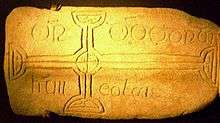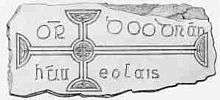Ódhrán Ua hEolais
| Odhrán Ua hEolais | |
|---|---|
 The cross-stone of Odhran Ua Eolais | |
| Born |
10th century Muintir Eolais |
| Died |
994 Clonmacnoise |
| Education | Monasticism, Letters |
| Occupation | Scribe |
| Home town | Muintir Eolais, County Leitrim IE |
| Relatives | Eolais Mac Biobhsach (grandfather) |
Odhran Ua hEolais (Irish: Ódhrán, Odhrán, Odrán, Odráin, pron. "Orin", dim. of Odar 'gray',[1] or "pale" anglicised "Horan",[2] and Irish: hEolais family name is still used today, anglicized as "Olus",[3] died AD 994), was a medieval scribe and scholar at the abbey of Clonmacnoise. He must have been born, and lived his childhood, in the medieval region of Conmaicne Réin, which corresponds to present day south county Leitrim. We do not know any significant details of his personal life, but Odhran moved to county Offaly in adult life, to become Lector and a famous scriba of Clonmacnoise.[4] His death is recorded in the Annals of the Four Masters. A cross-stone of Odhran, with his name inscription legible in middle Irish, is preserved to this day.
Life
Odhran was born into the Túath called Conmaicne Réin, present day south county Leitrim,[5] sometime in the first half of the 10th century. His family were gaelic nobles, and Odhran was probably grandson of Eolais Mac Biobhsach (Irish: Ua h-Eolais, "descendant of Eolais"), a charismatic leader who united all the disparate sept's of "Conmaicne Réin" territory, under his sole chieftain-ship", c. AD 900.[2] He received some sort of formal education, possibly in Fenagh or Mohill monasteries, in county Leitrim. He became proficient and literate in Irish language, Latin, bardic tradtion, and religious doctrine. He choose, or was reared into, a life of Monasticism.
Sometime in his adult life, he moved to Clonmacnoise, the celebrated early Irish Christian monastery, taking the position of ecclesiastical Lector and "scribe of Clonmacnoise".[2][6][7][8] Odhran probably shared duties for scribing manuscripts, and his contributions, if preserved over the centuries, may have been recorded in the Annals of Clonmacnoise.
Perhaps Odhran moved to Clonmacnoise to help secure burial rights in Clonmacnoise for Mag Raghnaill of Conmaicne Réin. There was an alleged controversy between Fearghal Ua Ruairc, King of Connaught (died. 964 AD[7]), and Brian Mag Raghnaill, a 10th century successor of Eolais Mac Biobhsach. Mag Raghnaill complained he had no place for a tomb at Clonmacnoise, unlike Fearghal Ua Ruairc, and so bestowed "48 ploughs" of Kiltoghert land to the bishop of Clonmacnoise[n 1] in exchange for a burial right.[4][9][10] It is tempting to suppose the appearance of Odhran Ua hEolais, an outsider, at Clonmacnoise is related to such matters.[n 2]
Death
The death of Odhran, c. AD 994, is recorded in the Annals of the Four Masters as follows:
- "994: and Odhran Ua h-Eolais, scribe of Cluain-mic-Nois, died", "Irish: & Odhrán ua h-Eolais, scribhnidh Cluana Mic Nóis, decc".[7][12]
Cross-slab

His cross-slab has been preserved, and four different sources interpreted the inscription as follows:
- OR DOODRAN HAU EOLAIS.[13]
- ÓŔ DÓ ODRÁN HÁU EOLÁIS.[14]
- O~R~ || D~O~ODRÁN | HÁU || EOLAIS, expanded as OROIT DO ODRÁN HÁU EOLAIS.[15][16]
- O~R~ || DOODRÁN | HÁU || EOLAIS, expanded as OROIT DO ODRÁN HÁU EOLAIS, and translated to "Pray for Odrán, descendant of Eolais".[2][15]
Instead of the more usual key-pattern, interlace and channels were used to ornament the central and boundary areas of the distorted cross motif on Ordan's stone, a decorative practice which dropped out of use on Clonmacnoise grave-slabs, c. AD 1000.[17] The cross on the "Ódhrán stone", a poor piece of work, may be regarded as an imitation of the design on the handsome stone of "Mael-Finnia", the Abbot of Clonmacnoise who died AD 991, as both stones share similar ornamental features.[18]
The awkward way in which the inscription was fitted on to the stone, introduces the notion these slabs were kept in stock in the monastery workshop, with pre-inscribed crosses, until a client name needed to be fitted in. This suggests Ódhrán commissioned the stone to request prayers for himself, implying the stone is not a grave memorial.[19]
John O'Donovan claimed this family name, (Irish: Ó hEóluis "descendent of Eolais"), can be found today, anglicized as "Olus",[3] but this "Olus" surname must be rare.[20]
Notes and references
Notes
- ↑ The term "48 ploughs" refers the quantity of land which can be ploughed in 48 days.
- ↑ Kehnel notes the alleged "Ua Ruaric tower" was not "finished" until A.D 1124,[7] Ua Ruairc had poor relations with Clonmacnoise, and only later tradition associates this tower with Ua Ruairc. But she agrees "curious tradition has it that one Fergal Ua Ruairc, chief of Breifne, was buried at Clonmacnois .. 10th century".[11]
Citations
- ↑ Macalister, pp. 93.
- 1 2 3 4 Petrie 1872, pp. 61.
- 1 2 O'Cleary, et. al. 1856, pp. 732.
- 1 2 Kehnel 1997, pp. 234.
- ↑ Kehnel 1997, pp. 282.
- ↑ Macalister 1909, pp. 97, 134.
- 1 2 3 4 AFM.
- ↑ Macalister 1949, pp. 54.
- ↑ Otway 1839, pp. 429.
- ↑ O'Donovan 1857, pp. 451-452.
- ↑ Kehnel 1997, pp. 232-233.
- ↑ O'Cleary, et. al. 1856, pp. 733.
- ↑ SMR No. OF005-023361 2011.
- ↑ Lionard, Henry 1960-1961, pp. 166.
- 1 2 Davies, Graham-Campbell 1999, pp. CLMAC/108/1.
- ↑ Macalister 1909, pp. xxvii.
- ↑ Lionard, Henry 1960-1961, pp. 142.
- ↑ Macalister 1909, pp. 100.
- ↑ Harbison 1995, pp. 202.
- ↑ Woulfe 1923.
Primary sources
- Petrie, George (1872). Christian Inscriptions in the Irish Language. Volume 1. Royal historical and archaeological association of Ireland, University Press. p. 61, f131.
- Annals of the Four Masters, ed. & tr. John O'Donovan (1856). Annála Rioghachta Éireann. Annals of the Kingdom of Ireland by the Four Masters... with a Translation and Copious Notes. 7 vols (2nd ed.). Dublin: Royal Irish Academy. CELT editions. Full scans at Internet Archive: Vol. 1; Vol. 2; Vol. 3; Vol. 4; Vol. 5; Vol. 6; Indices.
Secondary sources
- Macalister, Robert Alexander Stewart (1909). The memorial slabs of Clonmacnois, King's County : with an appendix on the materials for a history of the monastery (PDF). Dublin : University Press. p. 97.
- Woulfe, Patrick (1923). "Ó hEÓLUIS".
- Davies, Graham-Campbell, ed. (1999). "Celtic Inscribed Stones" (CLMAC/108/1 ed.). University College London.
- O'Donovan, John (1857). "The Registry of Clonmacnoise; With Notes and Introductory Remarks" (PDF). 1. The Journal of the Kilkenny and South-East of Ireland Archaeological Society: 444–460.
- Lionard, Pádraig; Henry, Françoise (1960–1961). "Early Irish Grave-Slabs". Proceedings of the Royal Irish Academy. Section C: Archaeology, Celtic Studies, History, Linguistics, Literature Vol. 61. Royal Irish Academy: 95–169. JSTOR 25505096. (subscription required)
- "SMR No. OF005-023361" (Archaeological Survey of Ireland ed.). National Monuments Service. 2011. Retrieved 25 October 2016.
- Harbison, Peter (1995). Pilgrimage in Ireland: The Monuments and the People. Syracuse University Press. p. 202.
- Kehnel, Annette (1997). Clonmacnois - the Church and Lands of St. Ciar'an: Change and Continuity in an Irish Monastic Foundation (6th to 16th Century). LIT Verlag Münster. p. 232.
- Otway, Caesar (1839). A tour in Connaught, by the author of 'Sketches in Ireland' [signing himself C.O.]. Oxford University. p. 429.
- O'Clery, Michael; O'Clery, Cucogry; O'Mulconry, Ferfeasa; O'Duigenan, Cucogry; O'Clery, Conary (1856). John O'Donovan, ed. Annala Rioghachta Eireann : Annals of the kingdom of Ireland (PDF). Volume 1. Dublin : Hodges, Smith.
Bibliography
- Macalister, Robert Alexander Stewart (1949). Corpus inscriptionum insularum celticarum. Vol. 2. (half-uncial inscriptions ed.). Dublin : Stationery Office, Irish Manuscripts Commission. p. 54.
External links
- O'Rourkes Tower at Clonmacnoise, http://www.megalithicireland.com/O'Rourke's%20Tower,%20Clonmacnoise.html